Get a grip on your to-do list with these top bench vises.
BobVila.com and its partners may earn a commission if you purchase a product through one of our links.
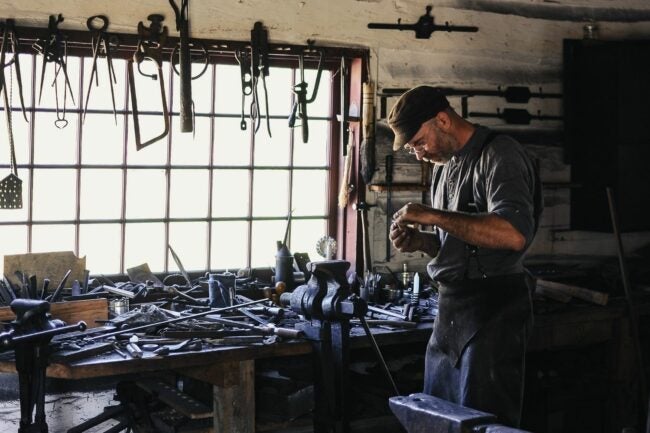
Photo: unsplash.com
You only have two hands—and that can often be a challenge in certain projects. Indeed, there may also be times when using your hands to hold a workpiece simply isn’t safe. The solution to these scenarios might just be a bench vise.
A staple in metalworking, automotive work, woodworking, and hobbyist shops, a bench vise is a metal clamping device that bolts to the top, side, or underside of your workbench. It has a screw mechanism that turns to open and close the jaws on a workpiece to hold it firmly in place, letting you perform tasks like cranking on a nut or bolt, or cutting perfectly accurate dovetail joints. A bench vise may also provide a solid surface to hammer against, making it an even more useful workshop staple. If you’re ready to increase your shop’s functionality, read on to learn about the different styles and features of the best bench vises—and to see why the following seven models are excellent options.
- BEST OVERALL: Yost Vises 908-AS 8″ Heavy Duty Steel Bench Vise
- RUNNER-UP: Wilton 11106 Wilton Bench Vise
- BEST BANG FOR THE BUCK: TEKTON 4-Inch Swivel Bench Vise 54004
- UPGRADE PICK: Wilton Model WS8 8-Inch Shop Vise
- BEST FOR METALWORKING: Forward DT08125A 5-Inch Heavy Duty Bench Vise
- BEST FOR WOODWORKING: Pony 27091 Medium Duty Woodworker’s Vise
- BEST WITH QUICK-RELEASE: Wilton – 78A, Pivot Jaw Woodworkers Vise (63144)
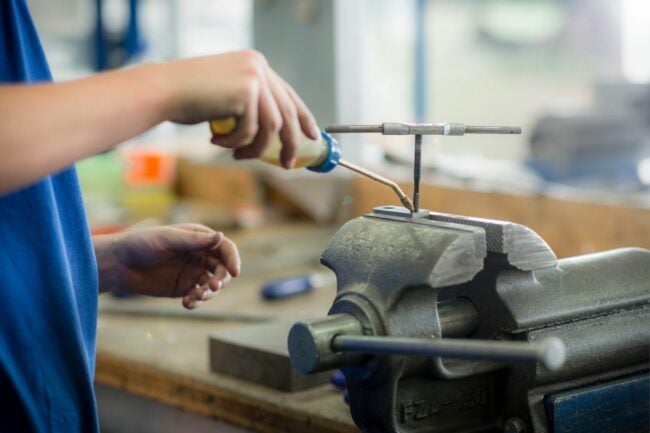
Photo: depositphotos.com
Types of Bench Vises
There are three main types of bench vises: benchtop, front, and end vises. Each style has its merits, though the project at hand will most likely determine which will work best for your needs.
Benchtop Vises
As the name suggests, benchtop vises (also known as machinists’ vises) mount to the top of your workbench. While some models clamp onto the workbench surface, some bolt directly through the table for the strongest possible attachment.
While some vises are suited to different tasks and materials, the benchtop vise is more of a “do-all” device. They have strong jaws and exert a lot of clamping pressure. They also hold the workpiece off of the table’s surface—very helpful for welding or wrenching. Though great for mechanics and metalworkers, their use for woodworking is somewhat limited.
Front Vises
Front vises mount to the front of your workbench. They’re popular among woodworkers because their position allows you to perform such tasks as planing, routing, or dovetailing without having a long piece of board jutting out into the middle of the workshop. Some of the best front vises feature rapid action, also known as a quick-release, which allows you to quickly adjust the vise to size on a workpiece before snugging it in place with a quick turn of the handle.
End Vises
End vises, which mount to the end of a workbench, look and work very similarly to front vises, though their intended use differs slightly. Woodworkers may opt for an end vise if they do a lot of surface planing and flattening—tasks that require complete stability from your workpiece. You can lay a board across the top of a bench, flip up the “dog” (a small metal peg that sits inside the jaw), place an additional dog in a hole in the work surface, and then tighten the vise to hold the board in place. Both dogs should sit below the board’s surface to limit the chances of striking the board with an expensive hand plane.
There aren’t a lot of other uses for an end vise, as most materials will stick out into the workshop if clamped into one.
What to Consider When Buying a Bench Vise
Not only does each style of bench vise have specific applications, aspects such as jaw width, quick-release, and swivel also make a huge difference in how well a vise will function in your shop. So acquaint yourself with the following features to help you choose the best bench vise for your needs.
Material
The most common material used for bench vises is cast iron. It’s incredibly tough and dense, allowing you to apply a great deal of clamping pressure—important for mechanical tasks like removing stubborn hardware or pressing bushings into automotive parts. Cast iron vises are also suitable to use as an anvil hammering surface.
Steel vises are also popular, as they’re strong and even more durable than cast iron. They can deform a bit under extreme pressure, however, and so they tend to be less expensive. Woodworking vises don’t require a ton of pressure to secure boards and workpieces in place, so steel is more than adequate for a front vise or end vise.
Note that manufacturers use PSI (pounds per square inch) as the measurement of the strength of their bench vises. Cast iron bench vises can have a tensile strength of over 60,000 PSI, making them incredibly strong. PSI ratings of 30,000 or more are sufficient for most workshop projects.
It’s also important to note that most of the best bench vises have replaceable jaws. This is a good feature because the jaws’ grippy surfaces can wear down over time, affecting their ability to grab hold of a workpiece. Replacing the jaws can extend the lifespan of your vise.
Jaw Width
Jaw width refers to the length of the vise’s clamping surface. Small vises can have jaw widths as small as 3 inches, making them suitable for light-duty projects and repairs. Large vises can have jaw widths as wide as 10 inches, which provides a lot of surface area for clamping large, heavy-duty projects in place. Generally, a functional jaw width is between 5 and 8 inches.
Woodworking vises tend to have very wide jaws to promote as much clamping surface as possible. These wide surfaces help avoid placing too much pressure on a small area, which could crush or mar the wood’s surface.
Jaw Opening
Jaw opening—the distance between the jaws when the vise is fully opened—is an important consideration, as it determines how wide of an item you can clamp in your vise. Commonly, most jaw openings match jaw width, so a 6-inch vise will have a 6-inch jaw opening and jaw width, though this isn’t always the case.
Woodworking vises like front- and end-mounted vises will have larger jaw openings for clamping wide boards in place. It’s not uncommon to find a woodworking vise with a jaw opening of more than 10 inches.
Throat Depth
Throat depth in both bench vises and woodworking vises refers to the distance from the top of the jaw to the top of the screw mechanism that tightens the vise. Essentially, it quantifies how deeply you can clamp a workpiece down inside of a vise.
Throat depth is important, particularly when edge planing wide boards or welding wide pieces of steel. The larger the throat depth, the easier it is to clamp these wide materials toward their centers, providing more stability and holding strength while allowing you to apply more leverage or weight. Generally speaking, the larger the vice, the deeper the throat depth.
Swivel Rotation
The ability to swivel is possibly the most important feature of a good benchtop vise. For instance, swiveling the jaws out of the way allows you to get a better angle on the anvil surface, which can make a big difference when you’re trying to strike or bend something to shape.
Swiveling also allows you to clamp a piece in place, and then spin it to adjust the vise’s angle instead of hunching over to see the back of the workpiece. It’s much more convenient and allows you to work ergonomically instead of straining to see what you’re doing.
Mount Type
Benchtop vises mount directly to your benchtop surface. They usually mount with four bolts that sandwich the vise’s base against the benchtop. It’s a good idea to mount a benchtop vise directly over a table leg. The leg will create a solid surface to hammer over, while the unsupported center of a bench may be overly bouncy and absorb a lot of your striking power.
Woodworking vises like front and end models mount in a few different ways. Commonly, they screw into the edge of your workbench with long wood screws or lag bolts. They can also mount from underneath with shorter screws—just be sure not to penetrate the work surface, or there is the risk of chipping a plane’s edge while flattening a board.
Anvil
Most benchtop vises have a flat surface on top, directly in the center, to function as an anvil. You can use this surface to hammer pins and rivets, as well as flatten or shape metal stock.
While not technically a blacksmith’s anvil, this surface does create a solid place to strike against. It can be helpful if you’re trying to knock a drift pin loose or flatten a bent lawnmower blade. The anvil surface won’t absorb the blow, which means it will direct the force into the workpiece. For this reason, the anvil surface is usually directly over the base, which makes it as sturdy as possible.
Woodworking vises don’t come with anvil surfaces, so woodworkers might want to install a benchtop vise on a shop surface for straightening antique nails and reclaimed hardware.
Quick Release
Screwing a vise in and out for workpieces that vary in width can be a sap on your workflow. It might take you 30 turns to open your vise’s jaws enough for a wide piece. Rather than waste time twisting your vise in and out of position, consider a model with a quick-release or rapid-action capability. These features allow you to quickly slide the vise into place, requiring only a quick twist of the handle to snug the workpiece—a real time saver.
Quick-release functions are typical in woodworking vises where you may go from edge planing a 3/4-inch wide board to flipping it on its side and flattening it across its 9 1/2-inch face. The ability to quickly pull and push the jaws into place can improve workflow considerably.
Our Top Picks
Now that you have an idea of which style of vise will work best for your bench and in your shop, you’re ready to start shopping. The following bench vises—from woodworking vises with quick-release functions to heavy-duty cast iron models—were selected taking the above factors into consideration.
Best Overall
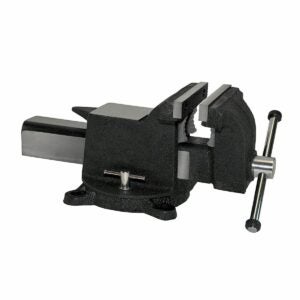
For a reliable, heavy-duty vise at a reasonable price, the Yost 908-AS 8-inch Heavy-Duty Steel Bench Vise is hard to beat. This vise features 60,000-PSI cast steel construction, an 8-inch jaw opening, and a throat depth of 3 1/2 inches. It swivels 360 degrees in either direction and comes with a flat anvil surface directly above the base.
The jaws are replaceable and feature pipe clamps that will hold pipes from 3/4 to 2 1/4-inches in diameter, useful in plumbing and metal fabrication shops. For added durability, Yost covers the jaw-screw with a square bar to keep errant wrenches and hammers from damaging the threads.
Runner-Up
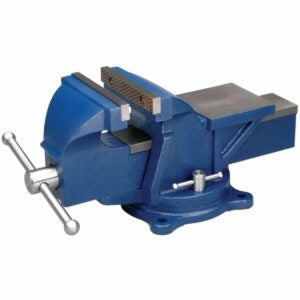
For a medium-duty, no-frills bench vise, the Wilton’s 11106 is worth checking into. This high-strength, 30,000 PSI steel vise has 6-inch wide serrated replaceable jaws and a jaw opening of up to 6 inches, which should cover most DIY and home workshop needs.
There’s a double-lock swivel base with roughly 160-degrees of rotation for getting a better angle on your workpiece. The vise also has a large, flat anvil work surface for hammering away at your to-do list. Wilton covers the jaw-screw with a square sleeve to keep it working as smoothly as possible while deferring damage. It lacks pipe clamps, however, so it is more difficult to secure round stock like pipes and metal tubing.
Best Bang for the Buck
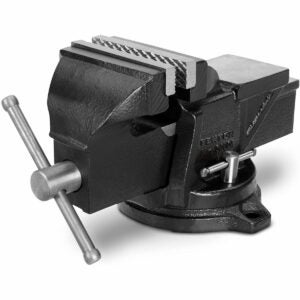
If you’ve got a relatively small workshop, bolting a huge, heavy bench vise to your workbench may not be the right move. Instead, consider this value-priced vise from TEKTON, which offers a little extra capability without being a behemoth.
The 30,000 PSI cast iron benchtop vise has 4-inch-wide replaceable jaws and a 4 5/8-inch jaw opening, more than enough for most DIYers. The vise swivels up to 120-degrees but holds its position with dual lock-downs, which tighten on both sides of the vise to secure it in place. It has a hidden jaw-screw for added protection and durability. The TEKTON also has a 2 5/8-inch square anvil surface, though it is slightly off-center of the base, so try hammering as close to the center of the vise as possible for the best results.
Upgrade Pick
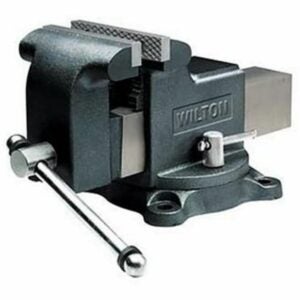
If you do a lot of plumbing or metal fabrication and need a top-notch benchtop to get the job done, check into the Wilton WS8 8-inch Shop Vise. This 30,000 PSI cast iron vise features 8-inch replaceable jaws, a jaw opening of up to 8 inches wide, and a throat depth of 4 inches. It can also clamp pipes as small as 3/4-inch in diameter and up to 3 inches—more than 1/4-inch larger than other models—to provide more capability than most other bench vises.
A 360-degree swivel base locks securely in place, while rubber guards on the T-handle help you avoid pinching your skin while tightening or loosening the vise. The WS8 also features a flat anvil surface centered over the base.
Best for Woodworking
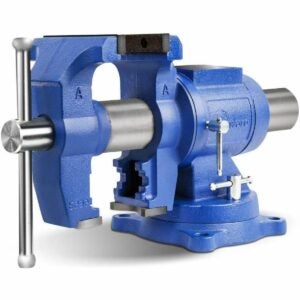
A woodworker in the market for a capable, quality front vise should look into Pony’s 27091 Woodworker’s Vise. The single-screw vise features cast iron construction, 7-inch jaws, and an 8-inch jaw opening capacity, providing enough clamping ability for some serious hardwood stock.
This vise mounts to the front of your woodworking bench with lag screws (sold separately). It has two additional holes on each jaw for securing sacrificial wood jaw inserts (blocks of wood that clamp against the workpiece to avoid the metal jaws marring expensive hardwoods). There’s also a slide-up steel dog in the outer jaw, allowing you to clamp your workpiece against a bench dog for surface planing and flattening. Plus, the orange enamel finish is baked on for extra durability.
Best for Metalworking
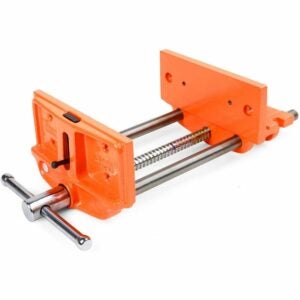
Metalworkers need a little extra capability from a bench vise, and this heavy-duty 5-inch model from Forward delivers. It features a 360-degree swiveling base and a 360-degree swiveling head, allowing you to clamp your workpiece in place and then position it at the proper angle.
One side of the head has 5-inch replaceable jaws and the other side has two replaceable V-jaws as well as self-aligning pipe jaws. The anvil surface is 3.2 inches long by 2.6 inches wide, providing an excellent surface for setting rivets or pins on. The body is made from 60,000 PSI durable ductile cast iron, making the Forward a durable, strong, and long-lasting vise.
Best with Quick-Release
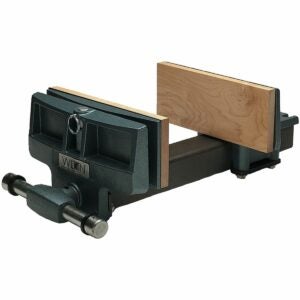
The Wilton 78A Pivot Jaw Woodworkers Vise will be right at home in the shops of the most discerning woodworkers. This vise has 7-inch wide jaws, a throat depth of 4 inches, and a maximum capacity of 10 inches, providing plenty of clamping ability for most woodworking applications.
The outer jaw pivots 10 degrees left and right to apply even pressure against uneven surfaces. The outer jaw also acts like a dog, lifting up 9/16-inch above the vise’s top, allowing you to plane and flatten boards. The quick-release “fast-action” nut allows you to quickly set the vise in place before snugging it down completely with a quick turn of the handle.
FAQs About Your New Bench Vise
Keep reading for answers to commonly asked questions about these useful workshop apparatuses.
Q. How does a bench vise work?
Bench vises mount to your workbench, either on top, on the front, or below. They use a screw-function to open and close a set of jaws that clamp your workpiece in place.
Q. How do you install a bench vise?
Install a benchtop vise over the top of one of your workbench’s legs to distribute force directly into the ground instead of absorbing it. Right-handed woodworkers typically like their front mount vises on the left side of their workbench and their end vices on the right end, while lefties prefer the opposite.
Q. How do you maintain a bench vice?
Cast iron is very durable, but rubbing it down with a water-displacing product like WD-40 will help keep your vise in great shape; spray the threads on the jaw-screw as well. When your jaws become worn—they’ll be noticeably smoother than when new—contact the manufacturer for a set of replacements.
tinyurlis.gdv.gdv.htclck.ruulvis.netshrtco.de
مقالات مشابه
- 'یک پل خیلی دور': Coronavirus عبارت گرفته شده از جنگ جهانی دوم
- از کجا تلویزیون سامسونگ اصل و گارانتی دار بخریم ؟
- 7 علائم شما درخت در حال مرگ است—و چگونه آن را ذخیره کنید
- شرکت صادرات و واردات کالاهای مختلف از جمله کاشی و سرامیک و ارائه دهنده خدمات ترانزیت و بارگیری دریایی و ریلی و ترخیص کالا برای کشورهای مختلف از جمله روسیه و کشورهای حوزه cis و سایر نقاط جهان - بازرگانی علی قانعی
- ونزوئلا برای اسکورت نفتکش ایرانی آوردن سوخت مورد نیاز
- شرکت صادرات و واردات کالاهای مختلف از جمله کاشی و سرامیک و ارائه دهنده خدمات ترانزیت و بارگیری دریایی و ریلی و ترخیص کالا برای کشورهای مختلف از جمله روسیه و کشورهای حوزه cis و سایر نقاط جهان - بازرگانی علی قانعی
- پروانه کسب چیست پروانه کسب جواز پروانه کسب ثبت بازرگان 125
- شرکت صادرات و واردات کالاهای مختلف از جمله کاشی و سرامیک و ارائه دهنده خدمات ترانزیت و بارگیری دریایی و ریلی و ترخیص کالا برای کشورهای مختلف از جمله روسیه و کشورهای حوزه cis و سایر نقاط جهان - بازرگانی علی قانعی
- مطلق بهترین راه برای ذخیره قهوه به گفته یک کارشناس
- این رسمی: ارتش است خلاص شدن از افسر, ارتقاء, تصاویر به کمک به از بین بردن تعصب